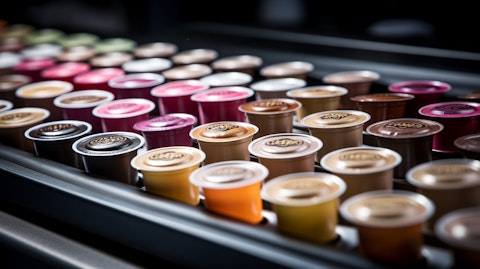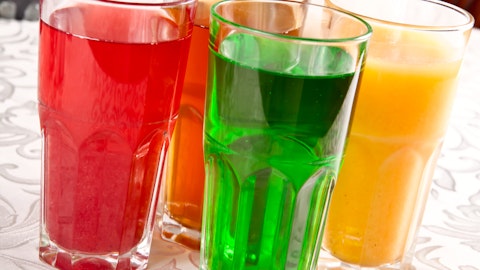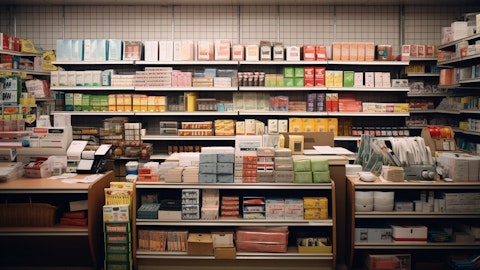Keurig Dr Pepper Inc. (NASDAQ:KDP) Q3 2023 Earnings Call Transcript October 26, 2023
Keurig Dr Pepper Inc. beats earnings expectations. Reported EPS is $0.48, expectations were $0.47.
Operator: Good morning, ladies and gentlemen, and thank you for standing by. Welcome to Keurig Dr Pepper’s Earnings Call for the Third Quarter Of 2023. This conference call is being recorded. [Operator Instructions]. I would now like to introduce Keurig Dr Pepper’s Vice President of Investor Relations and Strategic Initiatives, Jane Gelfand. Ms. Gelfand, please go ahead.
Jane Gelfand: Thank you, and hello, everyone. Earlier this morning, we issued two press releases, the first, detailing our third quarter 2023 results and the second, announcing our sales and distribution partnership with Grupo PiSA for Electrolit. During today’s call and consistent with previous quarters, we will be discussing our Q3 performance on an adjusted basis, which reflects constant currency growth rates and excludes items affecting comparability. The company believes that the adjusted basis while not in accordance with GAAP, provides investors with meaningful comparisons and appropriate insight into our business and operating performance trends. Details of the excluded items are provided in the reconciliation tables included in our press release and our 10-Q, which will be filed later today.
Due to the inability to predict the amount and timing of certain impacts outside of the company’s control, we do not reconcile our guidance. We’ll also speak about the concept of underlying performance, which removes the impact of nonoperational items in the current and prior years. These items include gains on asset sale-leaseback transactions, reimbursement of litigation expenses related to the successful resolution of our BodyArmor lawsuit, a business interruption insurance recovery, and a change in accounting policy for stock compensation. Finally, our discussion this morning may include forward-looking statements, which are subject to the safe harbor provisions of the Private Securities Litigation Reform Act of 1995. These statements are subject to a number of risks and uncertainties that can cause actual results to differ materially, and the company undertakes no obligation to update these statements based upon subsequent events.
A detailed discussion of these risks and uncertainties is contained in the company’s filings with the SEC. Here with us today to discuss our results our KDP Chairman and CEO, Bob Gamgort; and our Chief Financial Officer, Sudhanshu Priyadarshi. I’ll now turn it over to Bob.
Robert Gamgort : Thanks, Jane, and good morning, everyone. We are pleased with our Q3 results. KDP’s diversified beverage portfolio and strong execution continue to support consistent delivery of our company goals and commitments, even as the operating environment around us remains dynamic. In Q3, healthy organic sales growth and significant gross margin progress fueled reinvestment and bottom-line growth, reinforcing the ability to our full year outlook, which remains unchanged. Third quarter constant currency net sales grew 4.1%. As expected, net price realization moderated from the first half but remain the primary top-line growth driver, while volume mix strengthened sequentially. Our performance reflected continued share gains in U.S. Refreshment Beverages, gradual recovery in U.S. coffee segment results, and strong momentum in our International business.
Gross profit margin expanded significantly, up 100 basis points year-over-year and the largest improvement in four years, reflecting an improved balance between ongoing inflation, pricing and productivity. Gross profit growth enabled us to continue reinvesting in the business, including increased marketing for the third consecutive quarter, while simultaneously driving bottom line growth which was slightly above the expectations we shared with you back in July. As we move through Q4 and plan for next year, we expect our revenue growth drivers to continue to normalize as pricing moderates relative to recent history and volume mix continues to improve. To be clear, pricing is expected to remain a key part of the top-line equation, especially considering that inflation is likely to persist, albeit at more moderate levels than over the last couple of years.
Simultaneously, our focus will be on supporting volume mix by balancing margin flexibility between reinvestment and future top-line growth and earnings flow-through. Let me take a step back and frame how we assess consumer health, our portfolio, and our strategy in the macro environment. The consumer remains healthy with demand resilient and category elasticity is manageable. Even so, consumers are closely calibrating where and how they shop? For instance, growth in club and other value-oriented channels has accelerated while the convenience of e-commerce and pickup and delivery services continues to resonate well after any pandemic-related uplift would have normalized. Consumers remain responsive to high-quality innovation and activation, but price and package architecture is another increasingly important dimension, including smaller pack sizes that hit key price points and multipacks that offer value and convenience.
On the margin, we also see some migration of lower to middle-income households towards at-home meal and beverage occasions, which should benefit our more essential categories like CSDs and coffee. The business is well positioned against this backdrop, thanks to a compelling all-weather growth model. The ability to seamlessly meet the consumer across all beverage need states and to service those occasions across all channels is at the heart of why we formed this modern beverage company. Since then, we’ve made even more progress as we significantly grew the portfolio reach and strengthen our internal capabilities. Looking forward, our distribution prowess across retail is broad-based with very strong in-market execution yet we also enjoy a scaled online business, particularly on the coffee side.
Our robust 2024 innovation pipeline has been well received by the trade and spans product, format, and packaging news. It captures a combination of value and premium price points as well as low and no calorie and indulgent beverages. We also continue to price nimbly across the entirety of our portfolio, including by leveraging our strong mix management capabilities. In short, the consumer is resilient but choiceful and KDP is positioned to drive attractive top-line growth through a combination of volume, mix, and price levers. Our successful growth model rests on our exclusive focus on North American beverages and a winning strategy. It begins with KDP’s powerful twin distribution assets, our multichannel cold beverage distribution system, including DSD, and an installed base of nearly 40 million active households using the Keurig system.
This is an unparalleled combination in the industry, which enhanced by strong R&D and commercial backbone, enables us to grow our categories, and gain share across our base business, and further build out our portfolio through high-value M&A and partnerships with counterparties who increasingly seek us out. When we fill in category white spaces, such as through our announcement today of the partnership with Electrolit, fuels a virtuous cycle of growth, investment, and growing returns on that investment. As the new brand scale and our portfolio expands, our capabilities get stronger. Drop sizes get bigger, our merchandising gets more impactful, we service each store and household more frequently and our commercial and consumer relationships tighten.
This enables further investment in growth that begins to cycle anew. We have proven this model over multiple years. In U.S. Refreshment Beverages, we have consistently outperformed our categories, growing dollar share in at least 75% of our business in all but two quarters since the beginning of 2019. We also entered multiple strategic white spaces within the past 12 months such as ready-to-drink coffee, energy, and after today’s announcement, sports hydration, all were achieved in a very capital-efficient manner. The growth path ahead is increasingly evident with both owned and partner brands. The latter, where our relationships are strategic and long-term, growth and mix are positive, and our economics are attractive. Coffee, the single-serve segment has continued to steadily gain share of at-home coffee, cementing Keurig’s leadership position with this important category.
At the same time, we are expanding our total coffee strategy to encompass iced, ready-to-drink, and other forms of coffee within and beyond the K-Cup format. And in Canada and Mexico, we have leveraged similar strategies across our Refreshment Beverages and coffee business as well as deeply experienced local teams to build a combined business approaching $2 billion in revenue, with a mid-20s operating margin. As a result, our International segment has become a scaled contributor to the overall portfolio with significant growth runway ahead. I’ll now briefly discuss how this strategy played out in Q3, with Sudhanshu to follow with greater detail and guidance. In U.S. Refreshment Beverages, 82% of our business outpaced category growth in the quarter.
CSD business is healthy. Dr Pepper building on the momentum of strawberries and cream earlier in the year, with a successful sixth season of the iconic Fansville marketing campaign. Other brands such as Canada Dry and Squirt also saw strong gains. And Polar’s momentum continued in sparkling water, where it now commands the number two volume share position. CORE and Evian remains strong drivers in premium waters with CORE, in particular, seeing great traction from our partnership with U.S. gymnastics. That said, work to do elsewhere in the still portfolio including with buy, is undergoing a significant restage and reformulation next year. Importantly, our partnership with Nutrabolt on C4 is proceeding very well. In Q3, C4’s market share and earned display accelerated while velocities remain strong across those regions where KDP has taken control of the brand throughout the market.
Even as the C4 rollout continues in its first year, we have significant room for future growth in energy, where KDP’s market share is only 3%, and C4 has tremendous potential. With the Electrolit announcement today, we are extending our portfolio into the large and important sport hydration category, another quickly growing mix accretive white space for KDP. Electrolit is a brand that has established a strong regional foothold, thanks to its unique product attributes, scientific heritage, and extremely loyal customer base. The brand is the market leader in sports hydration in Mexico, and that popularity extends to the U.S. where Electrolit enjoys broad multicultural appeal but over-indexes with Hispanic consumers. Though it has good scale today in the U.S. and already generates more than $400 million in retail sales, representing more than a tenfold increase over the past five years, Electrolit has significant upside potential.
We are excited to partner with Grupo PiSA, Electrolit’s parent company, to meaningfully expand the brand’s distribution breadth and depth in the U.S. and across all channels while also leveraging KDP’s commercial expertise to further enhance the brand’s position at retail. With C4, Lock alone, and Electrolit having entered our portfolio over the last 12 months, we have meaningfully increased the growth potential for each of these brands while extending a positive halo on the rest of our business. For example, our total volume in chain convenience stores will increase by approximately 50% after incorporating these brands, providing scale and efficiency benefits across the entirety of our portfolio. This is the virtuous cycle that I described just a few minutes ago and which will continue to fuel KDP’s success.
Turning now to U.S. coffee, where our back half is focused on driving segment margin improvement in the context of gradually improving at-home coffee category volumes. With visible progress on both fronts, let’s address each in turn. I’ll start with the segment margin improvement. We have a greater ability to control in the short term than we do with category trends. Q3, we began to deliver against our objective with a strong inflection in segment margins and operating income, which meaningfully improved both sequentially and year-over-year. Importantly, we expect the margin improvements to continue. We previously said that delayed pricing would flow through our partner brands, and it has. We have now strengthened the pricing protocols across these long-term partnerships and do not expect any significant lag between inflation and pricing to recur in the future.
Plus, commodity cost headwinds are now moderating and productivity is building across the segment, enhancing our visibility to continuing to grow the bottom line even with ongoing reinvestment. Moving to category performance. At-home coffee category volume growth accelerated relative to Q2 but the pace of recovery is admittedly gradual. From Q2 to Q3, volume trends across the broader category strengthened by about 100 basis points in measured channels though volumes are still modestly lower year-over-year. Single-serve continues to gain share of at-home coffee with our proprietary data, which is more comprehensive spanning both measured and untracked channels, indicating that Q3 Keurig’s compatible pod consumption volume was approximately flat versus a year ago, proving from down approximately 3% in Q2.

These green shoots are encouraging, and we will continue to nurture them as the single-serve market share leader. During the quarter, we saw our competitors begin to lean more aggressively into price promotions in the single-serve category, resulting in some share shifts across the various brands in the ecosystem. As a reminder, because we manufacture nearly 80% of all Keurig compatible pods in the U.S., we tend to participate even share changes occur between our branded and private label partner brands and our owned and licensed brands. Nevertheless, we must responsibly manage our owned and licensed brands price gaps within the category and intend to stay nimble to the changing operating conditions around us. Importantly, as we choose to surgically respond to the recent price activity, we expect segment margins to accelerate in Q4.
We also do not expect the competitive pricing activity to meaningfully accelerate at-home coffee category buying, which we know are far more responsive to high-quality activities that influence consumer choice and lean into emerging trends. As the single-serve leader, KDP will continue to drive category growth as we always have through innovation, renovation, and white space expansion that build penetration with new households and increased usage among our existing consumers. With 90 million U.S. households drinking coffee at home, of which fewer than 40 million are actively using Keurig brewers, there is a significant multiyear opportunity ahead. In 2024, we will continue to pursue that growth through new consumables like cold brew, expanded ice varieties, and refreshers.
New brands like La Colombe, which, by the way, begins to ship in ready-to-drink and K-Cup format starting in Q4, significantly new innovation in brewers, all supported by strong marketing and brand activation activity, including exciting new collaborations across our owned and licensed brands. Moving on to our International performance in Q3, which remained impressive with revenue growth once again, in double digits and continued segment margin expansion. Both our Coffee and Refreshment Beverages businesses performed well. Canada, the ready-to-drink alcohol and no alcohol segment is growing, and we are contributing to that growth. ATP gained significant share as velocity and distribution built and a blast from the past, vodka-based Tahiti Treat RTD generated exceptional consumer demand.
In Mexico, our powerhouse Pena CL and Squirt brands, both grew at a double-digit rate, leveraging our strong go-to-market and DSD capabilities behind which we continue best. In Mexico, like in the U.S., we have significant growth potential ahead across both our core portfolio and through partnerships as we leverage these unique distribution assets. KDP’s strong balance sheet and cash generation profile are powerful enablers of our broader growth strategy with today’s Electrolit announcement yet another example of how we can grow our portfolio and market reach in a highly capital-efficient manner. As a result, our financial policy approach can be flexible and dynamic. This year, we are deploying some of our cash flow to strategically reduce our supplier financing program.
Simultaneously, we announced a 7.5% increase in our annual dividend furthering our track record of regularly growing dividend income for our shareholders. With over $3 billion remaining on our share buyback authorization and having already repurchased 24 million shares of KDP stock over the last two years, we have substantial flexibility to opportunistically lean in when we see compelling value in the business we know best. Wrapping up, our third quarter results represented another period of consistent delivery against our commitments. Our top-line growth was strong and resilient and we reinvested in our brands and differentiated capabilities. We also achieved important proof points in our margin recovery journey this quarter as visible in our consolidated gross margin progress, and in U.S. Coffee segment results.
Our Q3 results provide enhanced visibility to our unchanged 2023 outlook for constant currency net sales growth of 5% to 6% and adjusted EPS growth of 6% to 7%. We expect to close out 2023 having significantly improved our composition of earnings profile, lending further support to our aspiration to be on algorithm in 2024. I’ll now turn it over to Sudhanshu.
Sudhanshu Priyadarshi : Thanks, Bob, and good morning, everyone. Our consolidated third quarter results were solid. Top-line growth was resilient, and supported future momentum by reinvesting in the business and we delivered modest EPS upside relative to the expectations we shared with you last quarter. Revenue advanced 5.1% to $3.8 billion with healthy constant currency sales growth of 4.1%. Pricing remained the primary growth driver, contributing 5.5 points as expected by the moderation from the second quarter as prior year pricing actions were lapped. Volume mix strengthened sequentially, posting a modest 1.4% decline year-over-year. Gross profit margin inflected positively in the quarter and expanded a strong 100 basis points year-over-year as pricing and efficiency gains begin to offset input cost inflation.
Total SG&A deleveraged 130 basis points year-over-year, reflecting our focus to reinvest in our brands and capabilities while combating sustained inflation. SG&A saw another quarter of double-digit increases in marketing spending, while transportation, warehousing and other corporate costs such as labor remains headwinds. Adjusted operating income grew 3.1%, which, combined with below-the-line leverage, resulted in mid-single-digit EPS growth to $0.48, slightly ahead of the guidance we shared last quarter. We achieved this result without the benefit of any nonoperational gains in the quarter as we continue to make progress on reinforcing our earnings base looking out to next year. Moving to the segments. U.S. Refreshment Beverages grew net sales 5.9%, led by 7.1 percentage points of pricing.
The price contribution moderated quarter-over-quarter as anticipated as we begin to anniversary some of the last year’s pricing activity. Volume mix declined 1.2%, reflecting outperformance versus our categories across the vast majority of our portfolio and the growth contribution from C4 Energy. As Bob said, we expect price to remain a continued driver of the top-line growth algorithm in quarter four and into next year, even as growth rebalances across volume, mix, and pricing contributions. Consumer is resilient, category elasticities are manageable and inflation to moderating remains a headwind. Segment operating income grew 6.1% in the quarter and segment margins were approximately flat year-over-year. This performance reflected the favorable impact of pricing and productivity, net of inflation, offset by increased investment in marketing.
In U.S. Coffee, net sales decreased 3.2%, improving versus the second quarter trough as expected. Pricing sequentially strengthened and contributed 3.1 percentage points of growth. Some of this reflected pricing that lagged realized inflation across our partner portfolio and is now flowing through after a delay. In future cycles, we expect the pricing pass-through necessary to offset inflation to be more seamless. Volume mix declined 6.3% year-over-year in quarter three. Brewers grew 8% as we moved past destocking in the first half and shift in for the important holiday period. For the back half, as a whole, we expect brewer shipments to track point-of-sale strength, which remains softer in today’s macro environment and are still declining in the mid to high single digits compared to last year.
Importantly, Keurig brewers continue to gain share within the coffee maker category and we still expect to finish the year having grown penetration to approximately 40 million households in the Keurig ecosystem as compared to approximately 38 million at the end of 2022. All shipments declined 8%, similar to last quarter. However, by our measure, category consumption volume in single serve were flat year-over-year across all channels, a sequential improvement relative to quarter two. As we previewed would happen last quarter, shipments lagged category consumption in the period due primarily to two factors: First, the competition against a year ago channel inventory build; and second, the volume impact from our decision to exit certain low-margin private label contracts.
We anticipate a smaller combined impact from these factors in quarter four and expect all shipments to sequentially strengthen relative to quarter three. Office segment operating income grew 5.7% and operating margins expanded strongly. At near 33%, segment operating margins increased 280 basis points versus the prior year and also compared very favorably relative to 30.4% in the first half. The significant infection was driven by pricing, productivity, and moderating inflation, and we expect it to sustain. As Bob mentioned, the part of the expected revenue recovery is slightly altered relative to our original plan due to some prudent price arrangement in a competitive environment. Nevertheless, margin trends are expected to accelerate further in quarter four.
Fundamental progress is expected to drive continued solid operating income growth year-over-year even as we lap a difficult comparison given nonoperational benefits partially contributed to U.S. Coffee operating income last year. International segment sales increased 20.8% in the third quarter against a double-digit growth tempera in the year-ago period. Constant currency sales growth was very strong at 12.9%, with volume mix increasing 9% and pricing up 3.9%. Our top-line momentum are broad-based across Mexico and Canada. Segment operating income grew very strongly at 39.4% on a reported basis and 31.7% in constant currency terms, thanks to operating leverage and efficiency gains netting favorably against inflation. And anticipated, our free cash flow conversion strengthened sequentially in the third quarter to $459 million, reflecting the combination of profit growth and moderating working capital users and consistent with our expectation for free cash flow conversion to strengthen in the second half.
Our capital allocation approach remains unchanged. Our priorities include organic and inorganic investments to support our growth, further strengthening our balance sheet, consistent with our long-term net leverage ratio target of 2 times to 2.5 times, and returning cash to shareholders through our dividend and opportunistic share buybacks. We dynamically adjust between these priorities on an ongoing basis. In quarter three, we closed on the highly strategic La Colombe partnerships first introduced in July, which included a $300 million equity investment. Today, we announced another important partnership with Grupo PiSA to sell, distribute and merchandise Electrolit in the U.S. This is a meaningful step forward into sports hydration for KDP and establishes another mix accretive growth platform, even as it comes with minimal capital commitments.
As Bob pointed out, with entries into energy, RTD coffee, and sports hydration over the past 12 months, we have penetrated three large and important white spaces for a relatively modest capital outlay of less than $1.3 billion. We also have the ability and desire to continue to return cash to our shareholders. In September, we announced a 7.5% increase, marking our third consecutive year of growing our dividend and representing a cumulative 43% increase over that time. Our CRE purchases will remain opportunistic and we have demonstrated a willingness step in when our share price becomes dislocated from the long-term value we expect to create. The approximately $3.2 billion remaining on our share repurchase authorization, we will continue to assess the market for such opportunities.
Moving now to guidance. We are reaffirming our consolidated outlook for 2023 and continue to target constant currency net sales growth of 5% to 6% and adjusted EPS growth of 6% to 7%. Our EPS outlook assumes minimal benefits from nonoperational items in 2023, implying double-digit EPS growth on an underlying basis. Our guidance for below-the-line items is consistent with last quarter. For the year, we continue to expect interest expense in a $470 million to $475 million range, effective tax rate of 22% and approximately $1.41 billion diluted weighted average shares outstanding. We expect a strong end to the year in quarter four with similar top-line dynamics in quarter three and even a stronger gross margin expansion. At the same time, we will be lapping approximately $67 million of nonoperational gains in last year’s fourth quarter, primarily concentrated in the U.S. Coffee segment, which creates a challenging comparison.
Blending these factors together, we expect Q4 adjusted EPS of approximately $0.54 or 8% year-over-year growth. On an underlying basis, this represents strong double-digit EPS growth. With that, I will now turn the call back to Bob for closing comments.
Robert Gamgort : Thanks, Sudhanshu. I’d like to close by saying how excited we all are that Tim Cofer has joined KDP as Chief Operating Officer on November 6. From there, we are looking forward to a smooth CEO transition between Tim and me in Q2 next year in continuity as I serve as KDP’s Executive Chairman thereafter. Upon joining KDP, Tim’s immediate focus will be immersing himself in the business. He will also partner with Sudhanshu, the full executive leadership team, and me to drive our annual operating planning process for 2024. A lot of robust work is underway, and we expect to provide you with a detailed outlook when we report our Q4 results. For now, let me just say that our entire organization is focused on delivering a strong finish to 2023. We expect that Tim will join Sudhanshu and me in this forum in February and I know you will enjoy meeting him after that. I’ll now turn the call back to the operator for questions.
See also Movie Studio and News Media Stocks List and 10 Best Infrastructure ETFs.
Q&A Session
Follow Keurig Dr Pepper Inc. (NYSE:KDP)
Follow Keurig Dr Pepper Inc. (NYSE:KDP)
Operator: [Operator Instructions]. Our first question will come from Andrea Teixeira with JPMorgan. You may now go ahead.
Drew Levine : Hi, good morning. This is Drew Levine on for Andrea. Thank you for taking my question. So, I just wanted to ask on U.S. Coffee. If you could talk more specifically to the trends during the quarter, both in tracked and untracked channels, if the recovery is sort of playing out sequentially as you expected, and what we could think about the exit rate for September and October being? And then secondarily, I think the expectation was for pod volumes to perhaps see moderating declines in the quarter. They were pretty flat. So, anything changed incrementally during the quarter from a pod shipment perspective? Thank you.
Robert Gamgort : Sure, Drew. Thanks for the question. On our last call, we talked about drivers of improved coffee performance going forward. One was margin improvement and the other one was rebound in the total at-home coffee category. And so that goes beyond single-serve to all forms of coffee consumed at home. Obviously, as you saw in the results, we’ve received the — or we’ve experienced the inflection that we expected in the margin side, and that’s largely under our control and big driver of our performance. The category is experiencing sequential improvement. But admittedly, it is gradual. When we take a look at consumption of single-serve and we use our proprietary data, which looks at tracked and untracked channels and remember, the track channels represent roughly 60% of total consumption, we’re seeing that the volumes are flat, which is an improvement sequentially, but a bit slower than we expected.
And so that’s really the core of any shipment shortfall versus expectations is really driven by the category. I would remind you, within that, the single-serve and KDP continues to grow share within that category. The theme that we’ve talked about before about controlling the controllables margin share performance all are really quite good. The challenge is really this total at-home coffee category, which is moving in the right direction, albeit at a slower pace. My last comment on that is what we’re experiencing on at-home coffee in the U.S. is not unique to the U.S. It’s a trend that we’re seeing in most developed markets as well.
Operator: Our next question will come from Dara Mohsenian with Morgan Stanley. Your may now go ahead.
Dara Mohsenian : So, just to follow up, do you expect the category will continue to recover going forward sequentially from here? Can we get back to growth going forward? And maybe can you detail what’s driven the acceleration in untracked channels and how sustainable that is going forward? And then just second, if you could take a bit of a lookout to 2024, you mentioned on algo for the total company. Does that apply to the coffee business in terms of a more normalized organic sales growth and profit growth pace as you look out to 2024? Thanks.
Robert Gamgort : Sure. I think that when you take a look at the shipment — or the trajectory of the coffee category, I think it speaks for itself. We talked a lot about mobility as a big driver, and we certainly weren’t the only ones that were looking at that. So, mobility is no longer a factor. It’s gone back to a more normalized environment. And so, I think that the trajectory that we’re seeing right now on improved coffee consumption will continue. The drivers of that, I think it’s — there are multiple contributors to the slower but steady improvement in the category, including really a change in work routines, where you’re looking at more hybrid work. The afternoon occasion, for example, changes on that. On the margins, we could see some impact from pricing and inflation and also some of the trends in cold coffee, which also indexes to out-of-home.




